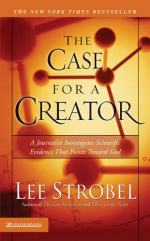|
This section contains 806 words (approx. 3 pages at 400 words per page) |

|
The Case For a Creator Summary & Study Guide Description
The Case For a Creator Summary & Study Guide includes comprehensive information and analysis to help you understand the book. This study guide contains the following sections:
This detailed literature summary also contains Topics for Discussion on The Case For a Creator by Lee Strobel.
The following version of this book was used to create this study guide: Strobel, Lee. The Case for a Creator. Zondervan. 2004.
The Case for a Creator is the nonfiction account of a journalistic investigation by Lee Strobel. In the book, Strobel studies, analyzes, and draws conclusions about the existence of God. Based on scientific evidence, the investigation points toward God. Previously an atheist, Strobel says that he turned away from God based on the theory of Charles Darwin regarding evolution. Darwin's theory states that nature, and not divinity, led to the existence of life. When Strobel’s wife became a Christian, Strobel decided to open his mind and consider all of the evidence for and against God’s existence.
Strobel’s book encompasses his investigation, where he interviewed various leading experts on questions relating to reason, science, and evidence. Strobel first met with Jonathan Wells, a molecular and cellular biologist who explained that much of the evidence regarding evolution has either been demonstrated a failure. Wells went on to say that some evidence has been faked. For example, Wells provided proof in the archaeopteryx, a half-bird, half-reptile presented as the missing link between dinosaurs and present-day birds. In reality, Wells explained, the archaeopteryx is actually a very old bird with modern feathers –which in and of itself gives pause to the theory of evolution.
Strobel then met with Stephen C. Meyer, philosopher of science, who explained that religion and science do not have to be enemies. Science should not be afraid of the answers, even if they are not naturalistic. Meyer argued that theories about the origin of life must be examined in light of the evidence, with evidence being critical. Additionally, some scientific truths which affect society and culture need religion and metaphysics to better understand them and their implications for the world.
Strobel continues his investigation by meeting William Lane Craig, PhD, a philosopher and theologian, who spoke of the Kalam Cosmological Argument. The argument of simple reason and logic states that anything which begins to exist must have a cause. Something cannot come from nothing, as many scientists believe.
Strobel next met with Robin Collins, PhD, who studied physics, mathematics, and philosophy. Collins explained how perfectly calibrated the universe and Earth are by way of governing laws, allowing for life. Such fine-tuning demonstrates intelligence rather than random chance or natural cause, both of which are mathematically highly improbable. Strobel decided to meet with Jay Richards, a philosopher, and Guillermo Gonzalez, an astronomer. Both had completed exhaustive studies on the Earth and the universe. They concluded that Earth is indeed a designed planet based on all of the evidence they could amass. The evidence ranged from the gravitational influence of the sun and the moon to the size of the Earth to plate tectonics allowing for landmass above water to Earth’s very place in its own solar system. These findings were amid countless others that pointed toward Earth being created by divine design
Lee Strobel then went to interview Michael Behe, PhD, a biochemist, who proffered the theory of irreducible complexity –that systems and organisms designed with multiple components could no longer function as intended, needed, or at all with a missing component. Behe then provided the example of cells which break down and cease to function without necessary components. In other words, simpler forms of these cells with fewer component parts could not have existed. Strobel then met again with Meyer, who revealed that cells, and their constituent components down to DNA, all operate according to information which govern their functions and purposes. This information does not arise naturally, as natural information would create repetitive patterns without variation. Likewise, events like the Cambrian Explosion (540 million years ago, in which most animal phyla first appeared suddenly in the fossil record, fully formed and without previous transitional ancestors) demonstrate the inexplicable nature of such needed information and that evolution could not have occurred so rapidly in so short a time span. Meyer uses this evidence to point toward a Designer.
Strobel last met with with J. P. Moreland, PhD (a nuclear chemist, theologian, and philosopher) to discuss the very idea of consciousness. Moreland explained that consciousness is not necessary for human survival. Furthermore, it cannot be accounted for in any naturalistic way. A human being and a dog do not need to understand that an apple is red to eat it. Likewise, things like theoretical thinking by the human mind are not necessary for survival. Consciousness allows for an understanding.
After concluding his interview with Moreland, Strobel went home and studied the evidence. Based on what he had learned, he became a believer in God. He found belief in God to be a natural thing based on the evidence, while Darwin’s theory of evolution was itself only a leap of faith.
Read more from the Study Guide
|
This section contains 806 words (approx. 3 pages at 400 words per page) |

|



